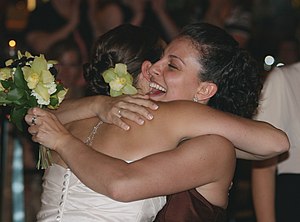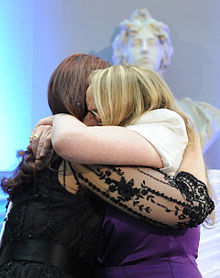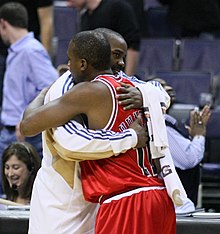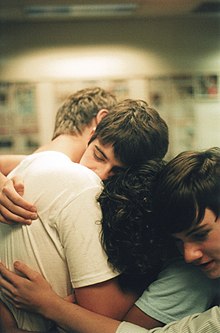| Revision as of 13:31, 29 April 2024 editThe Master of Hedgehogs (talk | contribs)Extended confirmed users4,020 editsNo edit summaryTag: Manual revert← Previous edit | Revision as of 13:32, 29 April 2024 edit undo98.118.102.98 (talk)No edit summaryTags: Reverted Visual editNext edit → | ||
| Line 1: | Line 1: | ||
| {{Short description|Form of endearment}} | {{Short description|Form of endearment}} | ||
| {{other uses}} | {{other uses}} | ||
| ] | ] | ||
| A '''hug''' is a form of ], found in virtually all ], in which two or more people put their arms around the neck, back, or waist of one another and hold each other closely. If more than two people are involved, it may be referred to as a ]. To perform a hug you must have casual feelings and have lots of charisma | A '''hug''' is a form of ], found in virtually all ], in which two or more people put their arms around the neck, back, or waist of one another and hold each other closely. If more than two people are involved, it may be referred to as a ]. To perform a hug you must have casual feelings and have lots of charisma | ||
Revision as of 13:32, 29 April 2024
Form of endearment For other uses, see Hug (disambiguation).
A hug is a form of endearment, found in virtually all human communities, in which two or more people put their arms around the neck, back, or waist of one another and hold each other closely. If more than two people are involved, it may be referred to as a group hug. To perform a hug you must have casual feelings and have lots of charisma
Etymology

The origins of the word are unknown, but two hypotheses exist. The first is that the verb "hug" (first used in the 1560s) could be related to the Old Norse word hugga, which meant to comfort. The second hypothesis is that the word is related to the German word hegen, which means to foster or cherish, and originally meant to enclose with a hedge.
Characteristics
 A so-called close-fisted hug after a volleyball match in Canada
A so-called close-fisted hug after a volleyball match in Canada
A hug, sometimes in association with a kiss, is a form of nonverbal communication. Depending on culture, context and relationship, a hug can indicate familiarity, love, affection, friendship, brotherhood, flirting or sympathy.
Hugs can indicate support, comfort, and consolation, particularly where words are insufficient. A hug usually demonstrates affection and emotional warmth, sometimes arising from joy or happiness when reunited with someone or seeing someone absent after a long time. A non-reciprocal hug may demonstrate a relational problem.
A hug can range from a brief one-second squeeze, with the arms not fully around the other person, to an extended holding. The length of a hug in any situation is socially and culturally determined. In the case of lovers, and occasionally others, the hips may also be pressed together. The emotionality of the hug can also influence the direction of the hug.
The direction of hugs generally corresponds with handedness, with right-handed people tending to lead with the right hand, but a heightened emotional state makes it slightly more likely for people to lead with the left hand. This small but significant effect has been attributed to right-hemispheric emotional processing.
Cultural aspects
 A hug in Argentina
A hug in Argentina A hug after a basketball game in the United States
A hug after a basketball game in the United States
While less common, hugging may be undertaken as part of a ritual or social act in certain social groups. It is a custom in some cultures such as France, Spain and Latin America for male friends to hug (as well as slap each other on the back) in a joyous greeting. A similar hug, usually accompanied by a kiss on the cheek, is also becoming a custom among Western women at meeting or parting. In Portugal and Brazil, it is common, mostly among males, to finish letters and emails with Um abraço or Abraço ("a hug", or "hug") followed by the sender's signature. Similar formulas may be used in oral communication. In the Roman Catholic rite of the Holy Mass, a hug may be substituted for a kiss or handshake during the kiss of peace ritual.
In May 2009, The New York Times reported that "the hug has become the favorite social greeting when teenagers meet or part these days" in the United States. A number of schools in the United States have issued bans on hugs, which in some cases have resulted in student-led protests against these bans.
A Canadian journalistic investigation in 2015 noted the popularity of the hug in bromance among young francophone adults in Quebec, Canada.
Unlike some other types of physical contact, a hug can be practiced publicly and privately without stigma in many countries, religions and cultures, within families, and also across most age and gender lines, but is generally an indication that people are familiar with each other. Moving from a handshake (or touch-free) relationship to a hug relationship is a sign of a closer friendship.
An unexpected hug can be regarded as an invasion of a person's personal space, but if it is reciprocated, it is an indication that it is welcome. Some Western culture commentators advise avoiding hugs at work to prevent uncomfortable moments, especially with people who dislike hugging. Also, a person, especially a child, may caress and hug a doll or stuffed animal. Young children also hug their parents when they feel threatened by an unfamiliar person, although this may be regarded as clinging onto rather than hugging because it demonstrates a need for protection rather than affection.
Some cultures do not use hugging as a sign of affection or love, such as the Himba in Namibia. During the Islamic fasting month of Ramadan, it is halal (permissible) for someone to hug one's significant other during daylight hours if one has self-control. However, if accompanied by libidinous urges, it is haram (sinful). Hugging between the opposite gender outside the same family is usually avoided in most Islamic communities.
Health benefits
Hugging has been proven to have health benefits. One study has even shown that hugs increase levels of oxytocin and reduce blood pressure. Hugging can also buffer against the release of the stress hormone cortisol if a romantic partner hug is shared before a stressful situation. This effect was however only observed for women and not for men. Research indicates that a 20-second-or-longer hug releases oxytocin.
Group hug
"Group hug" redirects here. For other uses, see Group hug (disambiguation).
A group hug involves more than two people embracing each other by wrapping their arms around one another in order to physically express their bond with each other. A group hug has been found to be a useful tool in group therapy to cement a sense of cohesion among the participants after a session, although it may cause discomfort for group members who shy away from physical contact.
Cuddling
"Cuddle" redirects here. For other uses, see Cuddle (disambiguation).Cuddling is a related form of physical intimacy in which two people hold one another in each other's arms for an extended period of time. Cuddling can be with family members, friends or lovers. Similar to hugging, cuddling is a more affectionate and intimate embrace, normally done for a longer period of time (usually lasting from a few minutes to several hours). In contrast to hugging, which can often be a nonverbal greeting or parting tradition, cuddling is usually shared between two people who are lying down together or sitting somewhere in an intimate manner. Like hugging, cuddling makes the body release oxytocin, which has a variety of effects. In some cities around the United States, cuddling has evolved into a social activity, where individuals gather for the purpose of cuddling.
See also
- Free Hugs Campaign
- Haptic communication
- Hug machine
- Pound hug
- Side hug
- Cuddle party
- Bear hug
- National Hugging Day
References
- "hug - Origin and meaning of hug by Online Etymology Dictionary". etymonline.com.
- Kathleen Keating (1994). The Hug Therapy Book. Hazelden PES. ISBN 978-1-56838-094-0.
- Packheiser, Julian; Rook, Noemi; Dursun, Zeynep; Mesenhöller, Janne; Wenglorz, Alrescha; Güntürkün, Onur; Ocklenburg, Sebastian (2018). "Embracing your emotions: Affective state impacts lateralisation of human embraces". Psychological Research. 83 (1): 26–36. doi:10.1007/s00426-018-0985-8. PMID 29349505. S2CID 12878780.
- Ocklenburg, Sebastian; Packheiser, Julian; Schmitz, Judith; Rook, Noemi; Güntürkün, Onur; Peterburs, Jutta; Grimshaw, Gina M. (2018). "Hugs and kisses – the role of motor preferences and emotional lateralization for hemispheric asymmetries in human social touch". Neuroscience & Biobehavioral Reviews. 95: 353–360. doi:10.1016/j.neubiorev.2018.10.007. PMID 30339836. S2CID 53011017.
- William Cane, The Art of Hugging: The World-Famous Kissing Coach Offers Inspiration and Advice on Why, Where, and How to Hug, St. Martin's Griffin, US, 2013
- Kershaw, Sarah (2009-05-27). "For Teenagers, Hello Means 'How About a Hug?'". The New York Times. Archived from the original on July 14, 2011. Retrieved 2009-05-29.
- Grant, Denise (2010-04-15). "Students pan hugging ban". The Courier. Archived from the original on 2012-03-20.
- "School Bans Hugs Over 2 Seconds". kpho. 2008-03-02. Archived from the original on Sep 17, 2008.
- Lili Boisvert, radio-canada.ca, Bromance : ces gars qui craquent pour leurs amis Archived 2016-09-11 at the Wayback Machine, Canada, January 19, 2015
- Duranti, Alessandro (1997-06-01). "Universal and Culture-Specific Properties of Greetings". Journal of Linguistic Anthropology. 7 (1): 63–97. doi:10.1525/jlin.1997.7.1.63. ISSN 1055-1360.
- "A New Rule For The Workplace: 'Hug Sparingly'". NPR. 2014-01-11.
- Archived October 20, 2014, at the Wayback Machine
- C. Arnold, Elizabeth; Underman Boggs, Kathleen (8 January 2015). Interpersonal Relationships: Professional Communication Skills for Nurses (7th ed.). Elsevier Health Sciences. p. 129. ISBN 978-0323328579.
- "How hugs can aid women's hearts". BBC News. August 8, 2005. Retrieved 2008-11-28.
- Light, Kathleen C.; Grewen, Karen M.; Amico, Janet A. (2005). "More frequent partner hugs and higher oxytocin levels are linked to lower blood pressure and heart rate in premenopausal women". Biological Psychology. 69 (1): 5–21. doi:10.1016/j.biopsycho.2004.11.002. PMID 15740822. S2CID 8570586.
- Berretz, Gesa; Cebula, Chantal; Wortelmann, Blanca Maria; Papadopoulou, Panagiota; Wolf, Oliver T.; Ocklenburg, Sebastian; Packheiser, Julian (18 May 2022). "Romantic partner embraces reduce cortisol release after acute stress induction in women but not in men". PLOS ONE. 17 (5): e0266887. Bibcode:2022PLoSO..1766887B. doi:10.1371/journal.pone.0266887. ISSN 1932-6203. PMC 9116618. PMID 35584124.
- Colino, Stacey (Feb 3, 2016). "The Health Benefits of Hugging". U.S. News & World Report.
- ^ Pesso, Albert (1969). Movement in Psychotherapy: Psychomotor Techniques and Training. New York: New York University Press. pp. 92–93. OCLC 89825.
- Milana, Charlotte (16 December 2021). "Cuddle Events, a New Way to Enjoy the Healing Power of Touch". Seattle Metro.
External links
![]() Media related to Hugging at Wikimedia Commons
Media related to Hugging at Wikimedia Commons